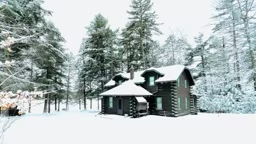
Radiant in-floor heating systems can be a fantastic way to keep your log home toasty, and there are a lot of reasons why you may want to consider this type of heat source.
Buyers seek out radiant in-floor heating systems for a variety of reasons:
- The consistency in temperature. You set the thermostat at a specific temperature and the system works on its own to maintain that temperature within the house.
- The heat starts at your feet. Radiant in-floor heat actually touches your body, allowing you to feel warmer. Then, the heat rises slowly. It doesn’t get drafty or lost in the rafters like many forced-air systems can.
- It's allergy-friendly. For people with dust or pollen allergies, radiant-heat systems make a lot of sense, as you don’t have nearly the amount of air pollutants flying around your home.
See also 7 Types of Popular Log Home Wood
Technical Considerations
There are different styles of radiant in-floor heating, from hydro-systems, where heated water circulates through pipes laid within the floor, to low-voltage electric in-floor heating (more of a supplemental heat source than a whole-house solution) suitable for kitchens, baths, rooms over garages, etc.
When we’re talking about choosing a hydro-radiant system as the primary heat source for your log home, it’s vital to get your general contractor and/or builder involved on the front end so he/she can anticipate what the energy demands of the house will be and help steer you toward a system that will meet those demands.
With hydro-radiant heat systems, the tendency is to locate it in the floor of the basement or main level of the home and let the heat rise to upper levels, rather than have a second series of tubing on the top floor. In this case, installing a mesh of electric in-floor heating pads beneath the finished floor in an upper-level bedroom or bath could be a good way to supplement your hydro-radiant system and keep your second-story spaces comfortable.
Also, remember that the heat for a radiant in-floor heating system has to come from somewhere. This means you’ll need a boiler that runs on some sort of energy, whether it’s wood-fired, a pellet stove, natural gas, propane or electricity, to warm the water. Solar power is another option, but it can be unpredictable and inefficient, since the sun isn’t as strong in the winter months, when you need your heating system most. Like the system itself, your heat source is something you have to account for early in the design and construction phase, so your log home is built to accommodate those needs.
See also Your Step-by-Step Guide to Log Home Construction
Construction Considerations
Your log home will need to be built so that it properly supports the radiant in-floor system, and this could involve some tweaks — particularly in the construction of your subfloors.
Radiant in-floor heating system manufacturers offer owners and builders assistance in different ways. In some cases, you can send your floor plan to them and they will create a complete design solution for your house, integrating it into plywood forms that already have the grooves for the piping cut into them, taking the guesswork out of the equation for your builder. Others design the system, but provide precise specifications as to exactly how they should be installed, giving your builder a road map instead of a template.
Regardless of how your system comes, your builder has to follow the instructions in detail, to the letter. Putting lines too close together or missing an area could create cold spots in your home, or worse, it could cause subcontractors, like finished-flooring installers, to inadvertently puncture the piping with a nail or screw if the heating system isn’t located where it’s supposed to be. Of course, the systems have allowances for things like finishing nails, so this shouldn’t be an issue, as long as care is taken to install the radiant system accurately.
Another reason it’s so important to decide if you’re going with a radiant in-floor heating system early in the game is because it can affect the height of your finished floor. The pipes and underlayment require extra space and can raise the floor height as much as 2 to 3 inches. The builder needs to ensure the elevation of the floor system is managed, so you don’t end up with a lip when you’re coming through the door. You’ll also have to plan a mechanical space big enough to allow access to the system, the heat source and the termination lines.
See also The Sacrifices of Building a Log Home
Operational Considerations
Like anything, a radiant in-floor heating system has its pros and cons. One negative is that when you turn it on, you don’t have that feeling of immediate heat being thrown into the room. The heat is gradual. So if you go away for a while and turn the setting down very low (which is not recommended, by the way), it will take time — maybe as much as several days depending on the size of the house — to warm the rooms once you fire the system back up. And, if you try to turn the system up high to speed the process, that can have negative effects.
For example: Your house is a seasonal home and you open it up to find the temperature is 65 degrees. So, you turn the radiant system up to 80 to warm it to 72 degrees faster, but the heat starts at the floor. You’ll be walking around on 80-degree tile or hardwood until you get the air temperature where you want it… not very comfortable. If the system is maintained at a constant level at all times, you won’t have temperature swings.
The bottom line is that radiant in-floor heating in a log home can make a lot of sense, but for the best result, make this decision early and make sure your entire design/build team is on the same page.
Dan Mitchell is a builder, Log & Timber Home University professor and the 2018 President of the Greater Knoxville Home Builders Association. He owns Eagle CDI in Tennessee.





_11868_2023-08-16_08-47-256x288.avif)

_11868_2023-04-27_10-18-256x288.avif)



